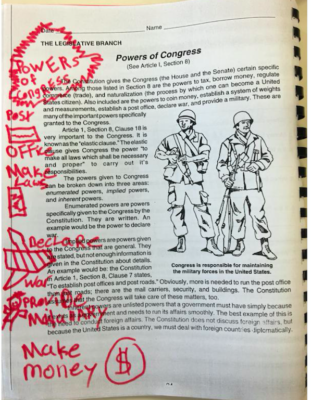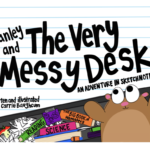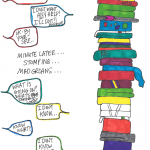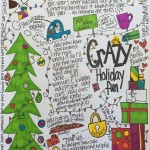The other day over sharing and talking visual note taking (sketchnoting) awesome a teacher said, “I just don’t know how to even get started with this in my classroom.”
Of course that question and the rush of the soon to be new school year got me thinking, “Why does sketchnoting have to feel so complicated or intimidating?”
While, learning the complete process of visual thinking, doodling and creating visual notes (sketchnotes) is way more than a single post. Getting started (like anything) doesn’t have to be scary or difficult. It is something (like anything) that you can dive in cannonball style and go all in or you can dip your toe in to and get into it little by little.
Whether you are ready to dip your toe into visual note taking and start slow or ready to dive right into it and looking for ideas to introduce it, the parts of visual thinking and visual learning are full of awesome ready to enhance learning and enrich your teaching. Here are some ideas to keep in mind, tips for thinking about it and ideas for how to start using it in your teaching and student’s learning…
Keep In Mind
- Adding elements of visual thinking and doodling to your instruction shouldn’t and doesn’t have to take over what your are already doing
- Visual thinking and doodling can be layered over what you are already doing
- The power of visual thinking and doodling begins with embracing what it is capable of and then using it to bring out the best in your teaching
Tips For Thinking About It
- Whatever fear, doubts, worries you have about your abilities to doodle…get over yourself! We all have to power and ability to doodle . It is the doodle that has the power not the art of it.
- Yes you have to! Yes, you have to draw for and with your students
- Talk Talk Talk! When it is time to think about learning, share your thinking with your students. “What movie is playing in your head?” “What picture is in your head?” “When I think of ________________________ it makes me imagine (share what you imagine)” “What are you imagining when you hear _______________?”
- There are no rules! The power of visual thinking and doodling is in the visualizing, doodle and doodling. How that looks in your students, for you and for your class should be what it needs to be and what meets their needs and their learning styles.
- “Sketchnoting is a form of Visual Writing by expressing ideas, concepts, and important thoughts in a meaningful flow by listening, processing, and transferring what you hear by sketching either by analog or digital.” Nuggethead
Ideas for Starting to Use It In the Classroom
Post-It-Notes: Post-Its are for more than your to do list or to stick a note to yourself on your computer.
- When reading text or listening to information: Students can write one fact with a doodle of it per post-it. The post-it can then be stuck next to the text in their book, on their desk or on piece a paper to build a future sketchnote.
- Building an Icon library: Students can explore a chapter / information before learning about it creating icons
 about the information they already know about the topic. The library can also be built throughout the lesson /chapter.
about the information they already know about the topic. The library can also be built throughout the lesson /chapter. - Mobile Doodles: Post-Its with information and doodles can go and stick anywhere…from the desk to the board to the wall or the floor making information visual and mobile
- Support All Learning: Post-Its with information pairedwith doodles supports all learning styles, hung in a classroom can be accessed by all students to aide in retrieving information and brought to their desks to support recall and idea production
Doodle On It!: Using consumables? Giving worksheets? Students taking notes? If its paper it is doodleable!!
- When reading text or listening to information: Students can doodle their learning, what they are visualizing right next to the text in the book
- Note taking with doodles: Already have a way you love teaching note taking? Ask students to add 3-5
 doodles (what they imagine in their head) next to the information they have written in their notes
doodles (what they imagine in their head) next to the information they have written in their notes - Give Them Permission to Doodle: Allow students to share their learning visually. Give them permission to share their thoughts and thinking on paper (its always about the doodle not the art…cant tell what the heck they doodled? Ask them,”Tell me about what you drew.” If they can follow it up with the correct information…power to the doodle yeah!)
- Support All Learning: Information paired with doodles supports all learning styles. Doodles on worksheets and notes can be more easily accessed by students. These doodles can also aide in retrieving information and support recall and idea production
Create A Learning Mascot: There is an inner learner in each of us. If you take a minute and listen its there. Sometimes it is funny. Sometimes it is sassy. Sometimes it is deeply reflective. Sometimes it speaks the truth. Sometimes it just whispers and our students do too!
- Imagine Your Inner You: Start to pay attention to that inner voice. Teach your students to. Then bring their inner voice, your inner voice, your learning mascot to life! Doodle an image, figure, a something that represent your inner you and their inner them.
- Unleash Your Learning Mascot Speak: Learning mascot is our inner voice, our ultimate learner, our unwavering cheerleader! It is also a doodle that when drawn over and over again, will get easier and easier, faster and faster to doodle. Pair it with a thought bubble or a talk bubble and now our learning mascots can join us in our learning, create a fearlessness in our thoughts and always be there to bring learning to life.

No matter how you decide to bring visual thinking and the doodle to your classroom the hardest part is picking up the pencil and the most powerful part will be when your students remember the power of theirs!




